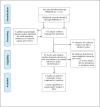The incidence and prevalence of neuromyelitis optica: a systematic review
- PMID: 24453773
- PMCID: PMC3883026
- DOI: 10.7224/1537-2073.2012-048
The incidence and prevalence of neuromyelitis optica: a systematic review
Abstract
Interest in neuromyelitis optica (NMO) has increased substantially over the last few years, but it is not known whether NMO has the same geographic and temporal variations in disease risk as multiple sclerosis (MS). We aimed to evaluate the worldwide incidence and prevalence of NMO through a systematic review of published peer-reviewed studies. We performed a search of the English-language literature using MEDLINE and EMBASE from January 1985 to March 2012. Search terms included "neuromyelitis optica," "Devic's," "opticospinal," "incidence," "prevalence," and "epidemiology." We assessed study quality using a standardized instrument. A total of five studies met the inclusion criteria. Three of the studies were from North America, and all studies were published between 2005 and 2012. All studies were of good quality, but only one study reported standardized rates, and subgroup-specific estimates were rarely reported. The incidence of NMO per 100,000 population ranged from 0.053 to 0.40, while the prevalence per 100,000 population ranged from 0.52 to 4.4. Heterogeneity was high among the incidence (I(2) = 68.0%) and prevalence studies (I(2) = 94.0%). This review highlights the limited knowledge regarding the epidemiology of NMO and the importance of obtaining estimates standardized to common populations to enhance comparability of studies from different jurisdictions. Future studies would also benefit from reporting age-, sex-, and race- or ethnicity-specific estimates.
Figures
References
-
- Wingerchuk DM, Lennon VA, Pittock SJ, Lucchinetti CF, Weinshenker BG. Revised diagnostic criteria for neuromyelitis optica. Neurology. 2006;66:1485–1489. - PubMed
-
- Pittock SJ, Lennon VA, Krecke K, Wingerchuk DM, Lucchinetti CF, Weinshenker BG. Brain abnormalities in neuromyelitis optica. Arch Neurol. 2006;63:390–396. - PubMed
-
- Lennon VA, Wingerchuk DM, Kryzer TJ. A serum autoantibody marker of neuromyelitis optica: distinction from multiple sclerosis. Lancet. 2004;364:2106–2112. et al. - PubMed
-
- Kira J. Neuromyelitis optica and Asian phenotype of multiple sclerosis. Ann N Y Acad Sci. 2008;1142:58–71. - PubMed
-
- Cree BA, Khan O, Bourdette D. Clinical characteristics of African Americans vs Caucasian Americans with multiple sclerosis. Neurology. 2004;63:2039–2045. et al. - PubMed
LinkOut - more resources
Full Text Sources
Other Literature Sources
Miscellaneous

